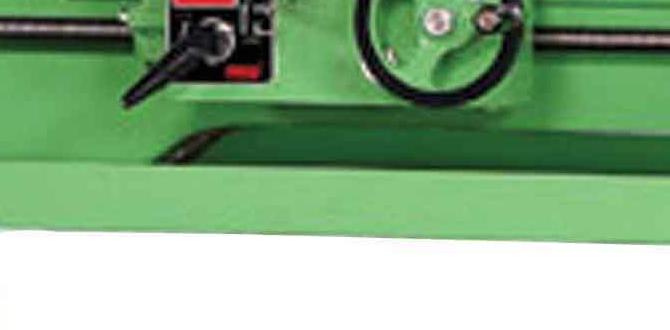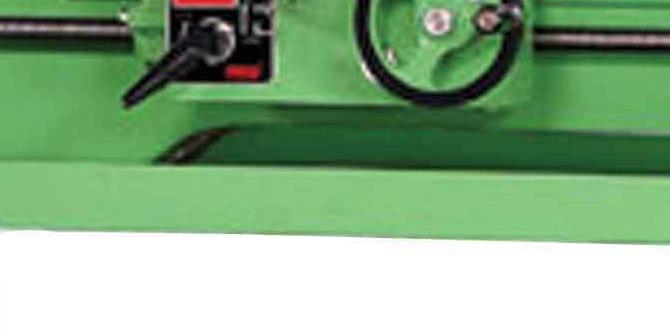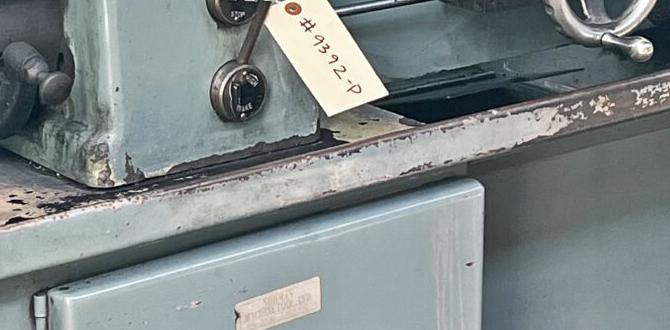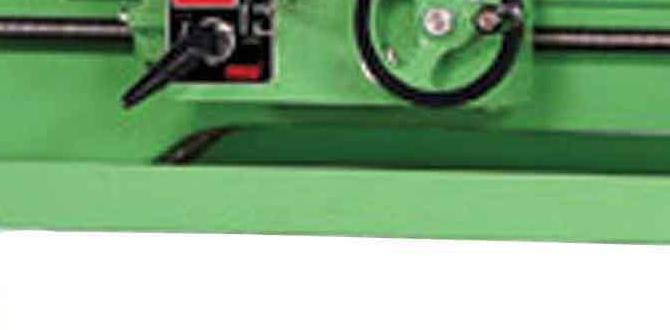Quick Summary
Choosing between an indexable face mill and a shell mill for 316 stainless steel depends on your project. Indexable face mills offer versatility and easy insert changes for various cuts, while shell mills excel in heavier, high-volume material removal with robust cutting power. Both are effective when used correctly.
Hey there, fellow makers! Daniel Bates here from Lathe Hub. If you’ve ever stood in front of a milling machine, tool catalog in hand, wondering which cutter is right for your 316 stainless steel project, you’re not alone. It can feel a bit like choosing a wrench – lots of options, and picking the wrong one means a less-than-perfect job. 316 stainless is a fantastic material, a bit tougher than its cousins, but it can be a real challenge to machine. Knowing your tools is key to getting smooth finishes, not fighting with chatter, and making your work go as smoothly as possible. This guide is all about clearing up the confusion between two popular workhorses: the indexable face mill and the shell mill. We’ll break down exactly what they are, how they’re different, and when to use each one, especially when tackling that stubborn 316 stainless. Let’s get your milling game leveled up!
Understanding Your Milling Cutters: Face Mills and Shell Mills
As machinists, we rely on our cutting tools to shape metal precisely. When it comes to flattening large surfaces or taking broad passes on a milling machine, two common tools come to mind: the indexable face mill and the shell mill. They might look similar at first glance, but their designs lead to different applications and strengths, especially when working with challenging materials like 316 stainless steel. We’ll dive deep into what makes each one tick.
What is an Indexable Face Mill?
An indexable face mill is a versatile milling cutter designed primarily for surface machining. Its defining feature is that it uses multiple individual cutting inserts, called “inserts” or “carbides,” that are clamped into slots on the cutter body. This means you don’t have to grind the cutting edges; when an insert wears out or chips, you simply replace that specific insert. This is a huge advantage in terms of time and maintaining cutting performance.
Think of it like a sophisticated, high-tech version of a knife with replaceable blades. The body of the face mill is robust, and the inserts are made from very hard materials like carbide, ceramic, or cubic boron nitride (CBN), chosen based on the material being cut. The inserts can be positioned at various angles to optimize the cutting action.
Key Features of Indexable Face Mills:
- Replaceable Inserts: This is the main selling point. Inserts can be easily swapped out when dull or damaged, offering cost-effectiveness and quick setup for new jobs.
- Versatility: Different types of inserts can be used in the same cutter body, allowing for a wide range of applications, from roughing to finishing, and for various materials.
- Adjustable Wies: Some indexable face mills allow for slight adjustments on the inserts to ensure they are all cutting at the same depth, which is crucial for achieving a flat surface.
- Variety of Grades: Inserts come in different materials (grades) and geometries (shapes) to suit specific workpiece materials and cutting conditions. For 316 stainless steel, you’d often look for specific grades designed to handle its toughness and tendency to work-harden.
What is a Shell Mill?
A shell mill, on the other hand, is a type of milling cutter that typically features multiple cutting teeth integrated directly into its body or mounted in a way that’s less modular than an indexable face mill. Historically, shell mills were often solid cutters, meaning the cutting edges were part of the cutter body itself. However, modern shell mills are frequently designed to accept specific inserts, but these inserts are usually larger and more specialized than those used in indexable face mills. They attach to a backing plate (the “shell”) which then mounts to the milling machine spindle.
Shell mills are generally built for heavy-duty tasks. They are known for their rigidity and ability to remove a lot of material quickly. Their larger cutting surfaces and robust construction make them ideal for taking deep cuts and tackling tougher metals.
Key Features of Shell Mills:
- Robust Construction: Designed for high material removal rates and heavy-duty applications.
- Large Cutting Diameter: Often available in larger diameters than indexable face mills, making them suitable for covering large surface areas quickly.
- Heavy-Duty Cutting: excels at roughing operations and taking aggressive cuts.
- Specialized Inserts (Often): While some are solid, many modern shell mills use larger, specific inserts, which are less numerous than in an indexable face mill, but built for power.
Indexable Face Mill vs. Shell Mill: The Key Differences
Now that we’ve got a basic understanding of each tool, let’s put them side-by-side. The choice between an indexable face mill and a shell mill for your 316 stainless steel projects often comes down to the specific demands of the job, the machine you’re using, and the desired outcome. Here’s a breakdown of their fundamental differences:
| Feature | Indexable Face Mill | Shell Mill |
|---|---|---|
| Cutting Elements | Multiple small, individual indexable inserts. | Fewer, larger inserts or integrated teeth. |
| Insert Replacement | Easy and quick replacement of individual inserts. Wide variety of insert geometries and grades. | Inserts can be larger and sometimes less standardized. Replacement might involve more components. |
| Applications | Surface milling, facing, perimeter milling, profiling. Good for a wide range of operations from roughing to fine finishing. | Heavy-duty surface milling, high material removal, roughing. Best for large, flat surfaces. |
| Cost per Edge | Lower cost per insert, but more inserts contribute to overall tool cost. | Higher initial cost per insert, but fewer are needed. |
| Versatility | High. Can adapt to different materials and tasks by changing inserts. | Moderate. Primarily designed for bulk material removal. |
| Machining 316 Stainless Steel | Excellent adaptability with the right inserts; can achieve good finishes. | Very effective for aggressive material removal, but might require specific insert geometries for optimal finish. |
| Tool Holding | Typically mounts via a central drive and a pilot hole in the cutter body, often with a clamping screw. | Mounts to a dedicated flange or arbor (the “shell arbor”) which then goes into the machine spindle. |
When to Choose an Indexable Face Mill for 316 Stainless
An indexable face mill is often the go-to for many machinists, and for good reason, especially when working with something like 316 stainless steel. Its modular nature is its superpower.
Advantages for 316 Stainless Steel:
- Material Specificity: You can get inserts specifically designed for stainless steels, including grades that resist the gummy nature and work-hardening of 316. Brands like Sandvik Coromant and Kennametal offer a wide selection.
- Surface Finish Control: With the right insert geometry, feed rates, and speeds, you can achieve surprisingly good surface finishes on 316, which can be tricky to get right.
- Flexibility: If your project demands both roughing and finishing passes, you can often use the same tool body by simply swapping to different inserts. This saves setup time and tooling changes.
- Cost-Effectiveness for Smaller Runs: For hobbyists or small-batch production, replacing individual inserts is far more economical than replacing an entire solid cutter.
- Reduced Chatter: The ability to finely tune insert angles and use specialized geometries can help mitigate chatter, a common problem when milling tougher steels.
When to Choose a Shell Mill for 316 Stainless
If your primary goal is to hog out material as quickly and efficiently as possible, a shell mill often takes the crown. It’s built for power.
Advantages for 316 Stainless Steel:
- High Material Removal Rate (MRR): Shell mills are designed to take deep radial and axial cuts, allowing you to remove significant amounts of 316 stainless steel in a single pass. This is crucial for bringing down large pieces or for initial roughing operations.
- Rigidity and Stability: Their robust design and often larger diameter contribute to a very rigid cutting system. This helps maintain accuracy and reduces the likelihood of the tool deflecting when pushing hard on tough materials like 316.
- Ideal for Large Surfaces: When you need to flatten a big plate or clear a large area, the wider cutting path of a shell mill can drastically reduce machining time compared to a smaller indexable face mill making multiple passes.
- Durability: Their heavy-duty construction means they can withstand the stresses of aggressive machining over long periods.
Factors to Consider When Machining 316 Stainless Steel
Machining 316 stainless steel presents unique challenges. It’s known for being “gummy” or tenacious, meaning it can tend to stick to the cutting edge, and it also has a tendency to work-harden rapidly. Selecting the right cutter is only part of the equation. You also need to consider proper cutting parameters and tool selection specifics.
Material Properties of 316 Stainless Steel
Understanding what makes 316 stainless tricky is essential for selecting the right tooling and approach. According to resources like the American Society for Metals (ASM), 316 is an austenitic stainless steel alloy that offers excellent corrosion resistance, particularly against chlorides. However, this toughness comes with machinability challenges:
- High Strength and Toughness: This requires cutters that can handle significant cutting forces without breaking or deflecting.
- Work Hardening: When 316 is machined, the surface layer can become significantly harder. This work-hardened layer can dull cutters quickly if not managed properly with appropriate cutting speeds and depths of cut.
- Tendency to “Gum Up”: The material can stick to the cutting edge, leading to poor surface finishes or built-up edge (BUE) on the insert, which can cause premature tool failure.
Essential Considerations for Your Cutter Choice and Setup:
When deciding between an indexable face mill and a shell mill, and preparing to cut 316 stainless, keep these in mind:
- Insert Material and Geometry: This is paramount for 316. Look for grades of carbide specifically suited for stainless steel (often designated with codes like “P30” or “P40” for toughness, or specific stainless steel product lines from tooling manufacturers). Negative rake inserts are often preferred for roughing stainless steels as they provide a stronger cutting edge and help manage chip formation. Positive rake inserts with chipbreakers can be used for finishing.
- Cutting Speeds and Feeds: 316 stainless doesn’t like to be rushed with high speeds. Generally, slower cutting speeds (SFM – Surface Feet per Minute) and moderate to high feed rates are recommended to prevent overheating and work hardening, and to ensure the material clears the flutes effectively. Always consult tooling manufacturer recommendations.
- Depth of Cut: For roughing, a substantial depth of cut with a shell mill can be very effective. For indexable face mills, the depth of cut will depend on the number of teeth engaged and insert strength. Avoid shallow cuts which can lead to rubbing and excessive heat buildup, accelerating work hardening.
- Coolant/Lubrication: Generous use of cutting fluid is essential. It lubricates the cut, cools the tool and workpiece (preventing work hardening), and helps evacuate chips. A good flood coolant system or even a high-pressure coolant system is highly recommended.
- Machine Rigidity: Your milling machine’s rigidity plays a huge role. A less rigid machine will vibrate more, leading to poor finishes and increased tool wear, regardless of the cutter choice.
- Tool Holding: Ensure your tool holder is strong and runout is minimized. A clean, stable connection between the spindle and the cutter is vital. For shell mills, this often means using a certified shell mill arbor.
Using an Indexable Face Mill on 316 Stainless Steel: A Step-by-Step Approach
Let’s walk through how you might use an indexable face mill to take on 316 stainless steel.
Preparation is Key:
- Select the Right Tool Body: Choose a sturdy face mill body, ideally with a design that accommodates specific stainless steel inserts.
- Select the Correct Inserts: Identify and install inserts specifically designed for machining stainless steel. For 316, consider uncoated or PVD-coated carbides in a grade known for toughness and heat resistance. Ensure they are sharp and properly seated.
- Set Up the Machine: Ensure your milling machine is clean, and the spindle is in good working order.
- Mount the Cutter: Securely mount the face mill onto its arbor or holder. Ensure zero runout when indicated.
- Program or Manually Set Toolpath: Determine your desired cutting strategy. Typically, you’ll want to take a full-width cut or an overlapping cut to ensure uniform surface finish.
Machining Process:
- Set Z-Axis Zero: Carefully bring the cutting insert down to the surface of your 316 stainless workpiece and set your Z-axis zero.
- Engage Cutting Fluid: Turn on your coolant system to flood the cutting area.
- Start the Cut: Begin with conservative cutting parameters. For 316, a good starting point for speeds might be in the range of 150-300 SFM, with feed rates around 0.005-0.010 inches per tooth (IPT). Refer to manufacturer data for precise recommendations.
- Make the Pass: Engage the feed. Observe the cutting action. Listen for unusual noises that might indicate chatter or load issues.
- Inspect and Adjust: After the first pass, stop the machine and inspect the surface finish and the inserts. Adjust speeds, feeds, or depth of cut as needed. If you see built-up edge on the inserts, you might need to increase cutting speed slightly, increase feed, or use a different insert grade/coating.
- Repeat for Desired Depth: Continue making passes to achieve your final depth, adjusting parameters as necessary.
Using a Shell Mill on 316 Stainless Steel: A Step-by-Step Approach
Shell mills are powerhouses for material removal, and using them correctly on 316 stainless steel can save you a lot of time.
Preparation is Key:
- Select the Right Shell Mill and Arbor: Choose a shell mill designed for heavy-duty face milling. Ensure you have the correct shell mill arbor to mount it securely to your machine spindle.
- Install Inserts (if applicable): If your shell mill uses inserts, install them securely. Again, choose inserts specifically rated for stainless steel, prioritizing toughness and heat resistance.
- Set Up the Machine: Ensure the machine is clean and ready for heavy work.
- Mount the Cutter: Mount the shell mill onto its arbor and then mount the arbor into the spindle. Ensure it’s runout-free and securely locked.
- Program or Manually Set Toolpath: For shell mills, often a single pass or a series of overlapping passes to cover the entire surface is used.
Machining Process:
- Set Spindle Speed: For 316 stainless, you’ll typically use lower spindle speeds, perhaps in the 200-400 SFM range as a starting point, depending on the machine and cutter.
- Set Depth of Cut: This is where shell mills shine. You can often take a significant depth of cut, perhaps 0.100 to 0.250 inches (2.5 to 6 mm) or more, depending on machine power and rigidity.
- Set Feed Rate: Use a healthy feed rate, typically 0.005 to 0.015 IPT, to ensure positive chip formation and to prevent rubbing.
- Engage Cutting Fluid: Crucial for 316. Ensure a robust coolant flow.
- Start the Cut: Plunge into the material or begin your axial engagement.
- Make the Heavy Pass: Let the shell mill do its work. The rigidity of the system is key here






